Small mammals
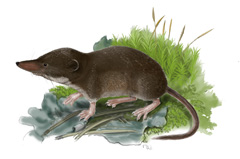
Common shrew (Sorex araneus)
Medium-sized shrew, with a general dark brown colour on the dorsal area and greyish on the ventral area. Opportunistic predator that feeds mainly on terrestrial and edaphic invertebrates. It has a relatively continuous distribution throughout the Catalan Pyrenees, penetrating through... Read more →
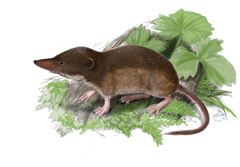
Crowned shrew (Sorex coronatus)
Medium-sized shrew, with a tricolour coloration: generally dark brown on the dorsal area, with lighter bands on the sides, and greyish coloration on the ventral area. Opportunistic predator that feeds mainly on terrestrial and edaphic invertebrates. It has a relatively continuous... Read more →
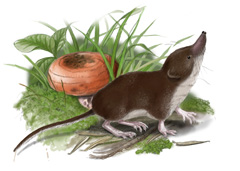
Eurasian pygmy shrew (Sorex minutus)
Small shrew, with a general coloration that is brown on the dorsal area and greyish on the ventral area. It feeds mainly on terrestrial invertebrates. It is evenly distributed throughout the north of the peninsula, making penetrations in more southern sectors of the mountains of the... Read more →
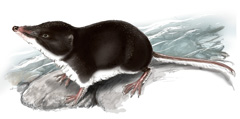
Water shrew (Neomys fodiens)
Large, semi-aquatic shrew that has certain morphological adaptations to swimming. It has a very contrasting coloration, with a very dark, almost black back, and a whitish or silver-grey belly. Opportunistic predator that feeds mainly on terrestrial and aquatic invertebrates. It has... Read more →
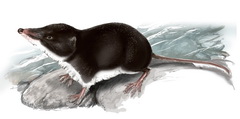
Miller's water shrew (Neomys anomalus/milleri)
Large, semi-aquatic shrew, but more terrestrial and smaller than the white-legged shrew. Black on the back and white on the belly. It feeds mainly on terrestrial and aquatic invertebrates. It has average European environmental requirements but less strict than its relative, generally... Read more →
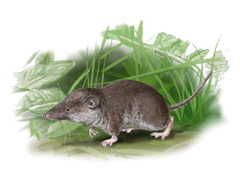
Greater white-toothed shrew (Crocidura russula) Moderate decrease
Medium-sized shrew, during the summer it presents a reddish-brown dorsal coloration and a short coat, while in winter it presents a longer and denser coat with a greyish dorsal hue. Adult males have lateral glands that give off a very strong odor that is easily detectable when handled.... Read more →
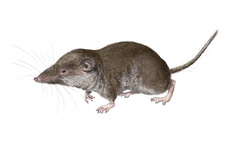
Lesser white-toothed shrew (Crocidura gueldenstaedtii)
Taxonomic changes would indicate a split between the group C.suaveolens (Asia) and C.gueldenstaedtii (Europe). Medium-sized shrew, very similar to the common shrew, with a greyish dorsal hue, and greyish ventral with yellowish tones. Species with Atlantic environmental requirements,... Read more →

Canary shrew (Crocidura canariensis)
Shrew endemic to the eastern Canary Islands (Fuerteventura, Lanzarote and its islets) of medium size and greyish fur, sometimes with a reddish sheen. Insufficiently known distribution, it could be conditioned by the presence of introduced mammals and the use of pesticides. In Lanzarote... Read more →

(Crocidura pachyura)
Ut viverra massa vel justo tristique mollis. Phasellus nec euismod mauris, id vulputate erat. Donec porta mauris quis sodales iaculis. Aliquam malesuada convallis libero sit amet aliquet. Proin a quam quam. Integer rhoncus viverra suscipit. Donec at porta dolor. Suspendisse rutrum mattis risus et aliquam. Donec in accumsan massa, tincidunt egestas odio. Sed nec elementum neque, non cursus diam.
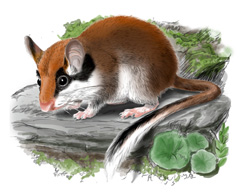
Garden dormouse (Eliomys quercinus) Stable
Medium-sized rodent, with reddish-brown dorsal fur, and a whitish belly. It has large ears, bulging eyes (surrounded by a characteristic mask of black hair), and a long tail covered in hair that forms a brush at the end. It is omnivorous, it can eat insects, some small vertebrates,... Read more →
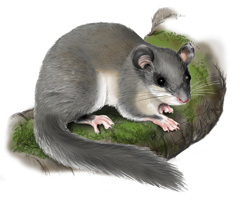
Edible dormouse (Glis glis)
Medium-sized rodent, with grey dorsal fur and a totally white belly. It has large black eyes that are surrounded by a small circle of black hairs. It is an arboreal, nocturnal animal, and one of the few wintering rodents found in the Iberian Peninsula. He is vegetarian and has a... Read more →
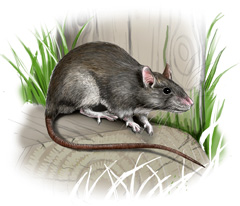
Black rat (Rattus rattus)
Large rodent, with a long body, tail and ears, and a pointed snout. The dorsal coloration is rather dark, while the ventral one is lighter (between white, yellow and grey). Thanks to its commensalism, it can be distributed throughout the territory, from very low levels near the sea, to... Read more →
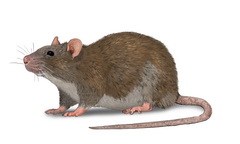
Brown rat (Rattus norvegicus)
Large rodent that is easily differentiated from its relative, the black rat, by its coloration and by having a more rounded snout and a tail that does not exceed the length of the head-body. It presents grey coloration on the back that delimits with a lighter or yellowish tone on the... Read more →
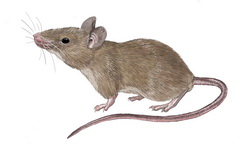
House mouse (Mus musculus)
Small rodent, slightly larger than the Algerian mouse, from which it differs by having larger ears and a longer tail in relation to the body. There are two main colours, one rather dark (greyish) that generally corresponds to commensal populations (that live in humanized environments),... Read more →
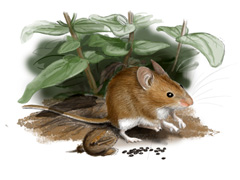
Algerian mouse (Mus spretus) Moderate decrease
Small rodent, with a rounded snout and short ears, and a tail that does not exceed the length of the body. It has light brown dorsal coloration and light ventral coloration (similar to the field mouse). Their diet is vegetarian, and is supplemented with small invertebrates. It is a... Read more →
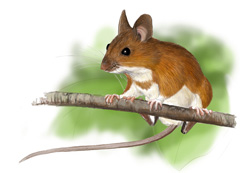
Yellow-necked mouse (Apodemus flavicollis) Stable
It is a small rodent with brown dorsal coloration (with reddish/golden hues) that contrasts strongly with the white ventral coloration in adult individuals. Their external appearance is very similar to that of the field mouse, as are their diet and... Read more →
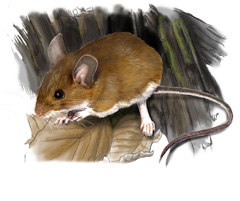
Wood mouse (Apodemus sylvaticus) Moderate decrease
It is a small rodent with brown dorsal and ventral white-gray coloration. It has a very varied diet, mainly based on seeds and some food of animal origin (invertebrates). It is the most abundant small mammal in forest environments and is a key taxon for its role in the diet of many... Read more →
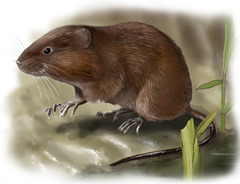
Water vole (Arvicola sapidus)
It is a rodent of the family of arvicolids of medium size and with adaptations to semi-aquatic life. Their fur is dense, short, and brown, and partially covers the ears. The belly is ash color with yellowish tones. It has a very specialized diet in stems and leaves of herbaceous plants... Read more →
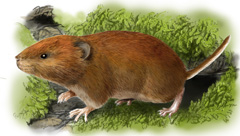
Bank vole (Clethrionomys glareolus) Stable
It is a small rodent of the vole family, with orange or reddish dorsal coloration, and ventral rather dark. It has small eyes, small ears but protruding from the fur, and a relatively short tail (half the length of the body). It feeds mainly on vegetables, although it can also eat... Read more →
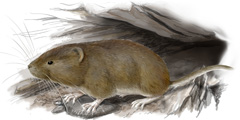
Snow vole (Chionomys nivalis)
Medium sized vole, with greyish dorsal and whitish ventral coloration. It has small eyes, ears protrude slightly from the fur, and has a relatively long and thick tail (half the length of the body). It feeds mainly on vegetables, although it can also eat invertebrates. It is a species... Read more →
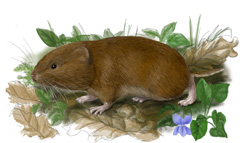
Mediterranean Field vole (Microtus lavernedii)
Recent taxonomic changes indicate that Iberian individuals would correspond to a different lineage than continental Europe (Microtus agrestis). Small vole with reddish-brown dorsal coloration (with golden tones) and grayish ventral. The fur completely covers the ears, and has a very... Read more →
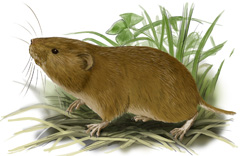
(Microtus arvalis)
Small vole with brown dorsal coloration and the belly is grayish with yellowish tones. The head is large, the neck short and the ears relatively protruding. It is a burrowing and underground life species. Mainly nocturnal, although they can present diurnal phases. It is a strict... Read more →
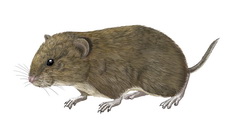
Cabrera vole (Microtus cabrerae)
Medium-sized vole, with brownish-gray dorsal coloration and ventral with yellowish tones. It has small eyes, ears protrude slightly from the fur, and has a relatively short tail. It feeds mainly on vegetables, although it can also eat invertebrates. It is a species of Mediterranean... Read more →
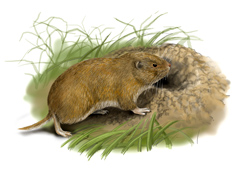
Mediterranean pine vole (Microtus duodecimcostatus)
Small vole, with general brownish-yellowish coloration and an ochre band that separates dorsum and belly. It presents morphological adaptations to underground life such as the reduction of the size of the eyes, ears, and tail. It feeds mainly on bulbs and vegetable roots. It is a kind... Read more →
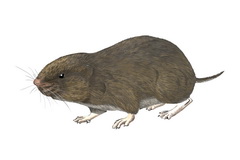
Lusitanian pine vole (Microtus lusitanicus)
Small vole, similar to the common vole, with general grayish coloration (with lighter to darker tones) and sometimes has an ocher band that separates dorsum and belly. Bicolor tail, discriminating criterion to differentiate it from the common vole. It presents morphological adaptations... Read more →
Contact | Legal notes | Credits | Subscripció al butlletí
